The hair straightener market is estimated to be valued at USD 7.1 billion in 2025 and is projected to reach USD 12.4 billion by 2035, registering a compound annual growth rate (CAGR) of 5.7% over the forecast period. Between 2025 and 2030, the market is expected to rise from USD 7.1 billion to USD 9.4 billion, driven by growing consumer demand for personal care and grooming products, especially with advancements in technology and design.
Year-on-year analysis shows steady growth, with values reaching USD 7.5 billion in 2026 and USD 8.0 billion in 2027, supported by innovations in ceramic, titanium, and tourmaline-coated plates that ensure smoother, faster styling. By 2028, the market is forecasted to reach USD 8.4 billion, advancing to USD 8.9 billion in 2029 and USD 9.4 billion by 2030. Growth will be further fueled by the rising preference for premium, long-lasting, and heat-efficient hair straighteners, as well as increasing adoption in both professional salons and at-home use. These dynamics position the hair straightener market as a growing segment within the beauty and personal care industry, with opportunities for product differentiation and enhanced consumer experience.
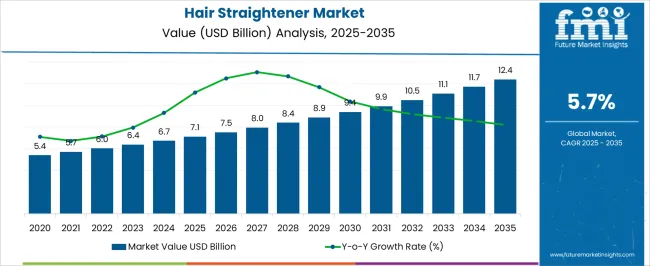
| Metric | Value |
|---|---|
| Hair Straightener Market Estimated Value in (2025 E) | USD 7.1 billion |
| Hair Straightener Market Forecast Value in (2035 F) | USD 12.4 billion |
| Forecast CAGR (2025 to 2035) | 5.7% |
The current market landscape is supported by a surge in disposable income and urbanization, particularly in emerging economies, which has led to greater adoption of advanced hair styling tools. Consumer awareness about hair care and the availability of multifunctional devices have influenced the demand for safer and more efficient straighteners.
Product innovation focusing on heat protection, material quality, and ergonomic design is contributing to sustained demand. Insights from beauty tech company press statements and annual investor updates indicate that evolving consumer expectations around convenience and styling precision are shaping new product launches.
The future outlook appears promising as brands continue to integrate technologies such as temperature control sensors and smart heat settings, enabling enhanced performance with minimal hair damage. This evolving product landscape is expected to pave the way for expanded market reach across both developed and developing regions.
The hair straightener market is segmented by product type, material, shape, power source, technology, end use, distribution channel, and geographic regions. By product type, the hair straightener market is divided into Flat irons & brushes, Hot air brushes, Curling irons, straightening brushes, and Others (wavers, wands). In terms of material, the hair straightener market is classified into Ceramic, Tourmaline, Titanium, Teflon, and Others (including combined, luxury, and heat shea butter). Based on shape, the hair straightener market is segmented into Flat, Rounded, Crimped hair irons, and Others (hot brush). By power source, the hair straightener market is segmented into Corded and Cordless.
By technology, the hair straightener market is segmented into Ionization, Steam technology, Infrared heat, and Others (dual voltage, temp control). By end use, the hair straightener market is segmented into individual and commercial. By distribution channel, the hair straightener market is segmented into Offline and Online. Regionally, the hair straightener industry is classified into North America, Latin America, Western Europe, Eastern Europe, Balkan & Baltic Countries, Russia & Belarus, Central Asia, East Asia, South Asia & Pacific, and the Middle East & Africa.
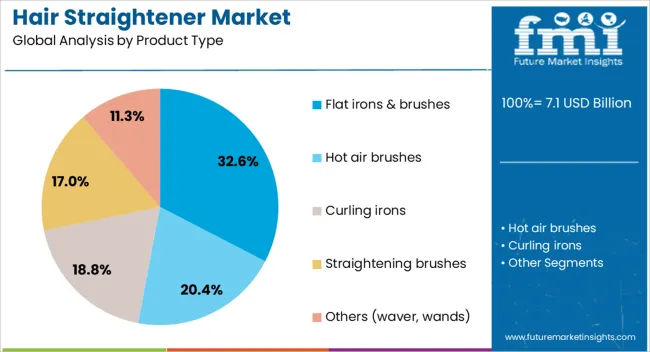
The flat irons and brushes product type segment is projected to account for 32.6% of the Hair Straightener market revenue share in 2025, positioning it as the leading segment. This prominence is being driven by the widespread consumer preference for dual-functionality styling tools that combine straightening and detangling in a single device. Product announcements from leading beauty appliance brands have highlighted user demand for quick styling solutions that reduce styling time while maintaining hair health.
The ability of flat irons and brushes to provide salon-like results at home has significantly influenced their adoption, especially among consumers with busy routines. Consistent product innovations also support the segment’s dominance focused on safety features, ceramic heating plates, and frizz control.
Enhanced convenience and user-friendly design have further strengthened the appeal of these devices across age groups and hair types.
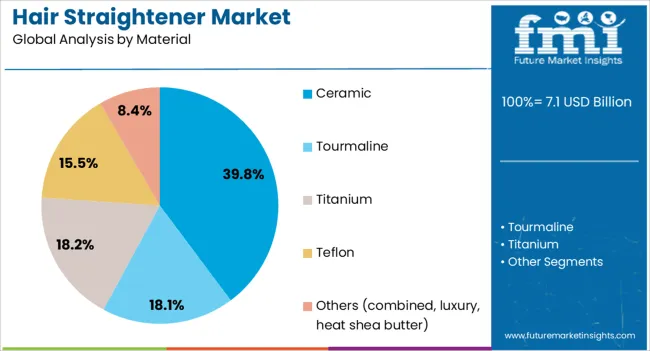
The ceramic material segment is expected to hold 39.8% of the Hair Straightener market revenue share in 2025, establishing it as the most preferred material type. This leadership is being reinforced by the material’s ability to deliver even heat distribution, thereby reducing the risk of hair damage during styling. Technical documentation from beauty appliance manufacturers and product feature briefings has highlighted ceramic’s role in maintaining consistent temperatures while minimizing hot spots.
Consumer safety and styling performance have been cited as key priorities in recent product launches, where ceramic components have been integrated to enhance straightening efficiency without compromising hair texture. Additionally, ceramic-based devices are known for their durability and affordability, making them accessible to a wide demographic.
These characteristics have contributed to strong market uptake in both salon and home-use settings. The continued focus on safe, smooth, and professional-grade results is expected to uphold ceramic’s dominant share in the years ahead.
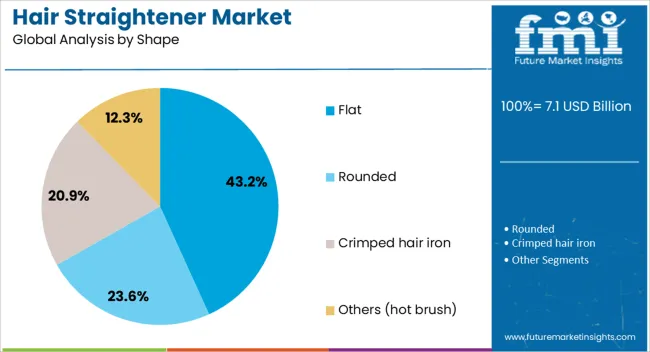
The flat shape segment is projected to contribute 43.2% of the Hair Straightener market revenue share in 2025, maintaining its position as the most widely adopted shape format. Its dominance is attributed to the uniform styling output it delivers across different hair lengths and textures. Corporate product manuals and customer usage data have underscored the flat shape’s advantage in applying consistent pressure and heat, which leads to more precise and efficient straightening.
The straightforward design also enables ease of use and faster styling, which resonates with consumer demand for convenience. Manufacturers have increasingly focused on ergonomic improvements and heat-resistant coatings in flat-shaped tools, enhancing user experience and safety.
The versatility offered by flat-shaped straighteners has made them a staple in both personal and professional grooming spaces. These factors have continued to support the segment’s leadership, with strong retention among repeat buyers and expanding adoption in emerging markets.
The hair straightener market is driven by increasing demand for personal grooming tools, with opportunities in expanding beauty and personal care markets. Emerging trends in smart, multifunctional styling tools are reshaping the market, while challenges like high competition and price sensitivity remain. By 2025, overcoming these obstacles through innovative features and competitive pricing will be essential for sustained growth and success in the hair straightener market.
The hair straightener market is expanding due to the increasing demand for personal grooming and styling tools. As consumers become more aware of beauty and appearance, the need for effective, time-saving hair styling products is growing. Hair straighteners provide a convenient way to achieve sleek, smooth hair at home, driving their popularity among both men and women. By 2025, the demand for hair straighteners will continue to rise, particularly with the growing preference for professional-level styling results at home.
Opportunities in the hair straightener market are growing with the expansion of the beauty and personal care markets. The increasing consumer focus on hair care and styling, along with the rising popularity of beauty trends, is driving the demand for advanced styling tools. Hair straighteners, which offer precision and convenience, are gaining traction among a broader consumer base. By 2025, the growing beauty industry, particularly in emerging markets, will create new opportunities for hair straightener manufacturers.
Emerging trends in the hair straightener market include the rising demand for smart and multifunctional hair tools. Features like temperature control, heat protection technology, and fast styling capabilities are gaining popularity among consumers seeking convenience and safety. Additionally, smart hair straighteners that integrate with mobile apps for personalized styling are expected to grow in popularity. By 2025, these trends will shape the market as consumers prioritize customization, advanced technology, and ease of use in their styling tools.
Despite growth, challenges related to high competition and price sensitivity persist in the hair straightener market. The market is highly competitive, with numerous brands offering similar products at varying price points, making it challenging for companies to differentiate themselves. Additionally, price-sensitive consumers often opt for more affordable options, limiting the profit margins for manufacturers. By 2025, addressing these challenges through unique product features and competitive pricing strategies will be crucial for maintaining market share.
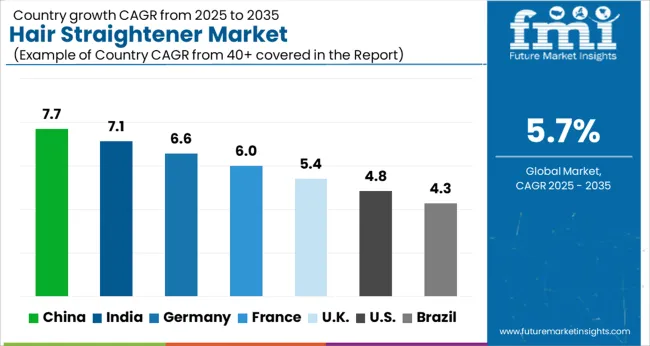
The global hair straightener market is projected to grow at a 5.7% CAGR from 2025 to 2035. China leads with a growth rate of 7.7%, followed by India at 7.1%, and Germany at 6.6%. The United Kingdom records a growth rate of 5.4%, while the United States shows the slowest growth at 4.8%. These varying growth rates are driven by factors such as the rising demand for personal grooming products, increasing disposable incomes, and growing awareness of beauty and self-care. Emerging markets like China and India are experiencing higher growth due to increasing urbanization, evolving beauty standards, and the growing influence of social media, while more mature markets like the USA and the UK see steady growth driven by innovation, consumer preferences for convenience, and premium product offerings. This report includes insights on 40+ countries; the top markets are shown here for reference.
The hair straightener market in China is growing rapidly, with a projected CAGR of 7.7%. The rising disposable incomes, changing beauty standards, and increasing demand for personal grooming products are driving the adoption of hair straighteners in the country. Additionally, China’s strong focus on fashion and appearance, combined with the influence of social media and beauty influencers, further contributes to the demand for high-quality, innovative hair styling products. The increasing availability of both affordable and premium hair straighteners, along with growing e-commerce platforms for beauty products, is accelerating market growth.
The hair straightener market in India is projected to grow at a CAGR of 7.1%. India’s increasing focus on personal grooming and self-care, along with rising disposable incomes, is driving the demand for hair straighteners. The growing middle class and urbanization, coupled with the increasing influence of Western beauty trends and social media, are contributing to market growth. Additionally, India’s expanding online retail sector and increased accessibility to beauty products, including affordable and premium hair straighteners, further accelerate market adoption.
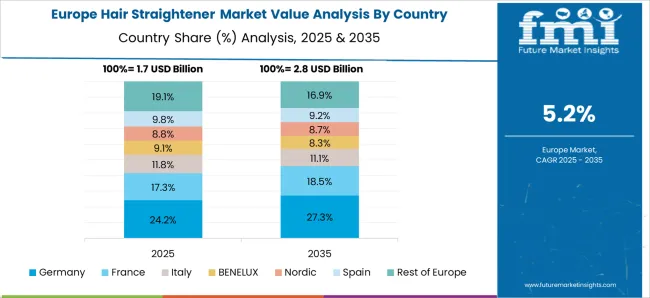
The hair straightener market in Germany is projected to grow at a CAGR of 6.6%. Germany’s growing demand for personal grooming products, especially hair styling tools, is driven by the increasing emphasis on beauty and self-care. The country’s well-established retail infrastructure and growing consumer interest in premium and technologically advanced beauty devices further support market growth. Additionally, Germany’s focus on sustainable and eco-friendly product offerings, along with rising demand for multi-functional and durable hair straighteners, is contributing to steady market expansion.
The hair straightener market in the United Kingdom is projected to grow at a CAGR of 5.4%. The UK’s growing demand for hair care and styling products, along with the increasing influence of beauty trends and social media, is contributing to steady market growth. The increasing preference for premium, high-performance products and the rising availability of both affordable and high-end hair straighteners in retail and online platforms further accelerates market adoption. Additionally, the UK’s growing focus on sustainability in beauty products, with an emphasis on eco-friendly materials and ethical sourcing, is driving market innovation.
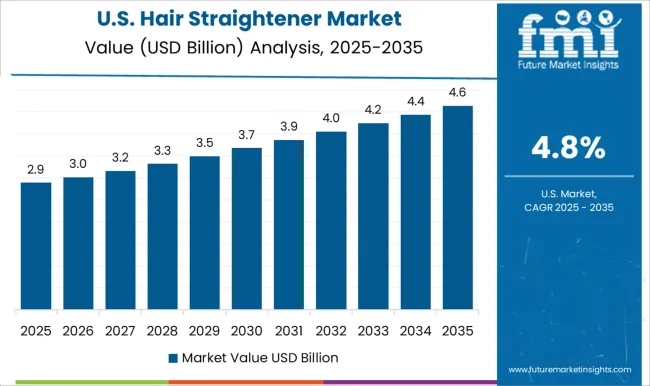
The hair straightener market in the United States is expected to grow at a CAGR of 4.8%. The USA market remains steady, driven by consumer demand for high-quality, innovative hair care products, particularly those offering advanced features such as temperature control and heat protection. The growing popularity of hair straighteners among both men and women, coupled with the rising trend of home grooming, is contributing to market growth. Additionally, the USA focus on premium beauty products, along with the increasing availability of hair straighteners through e-commerce and retail channels, ensures a steady demand for these products.
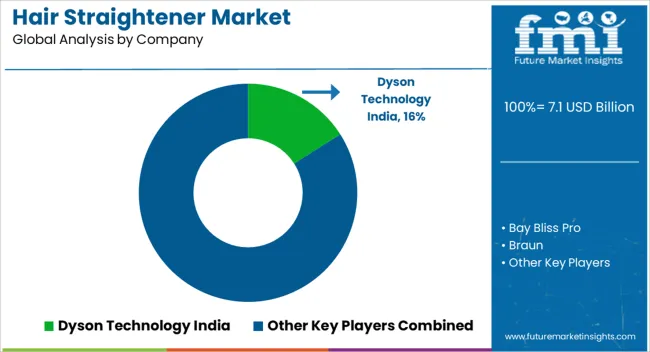
The hair straightener market is dominated by Dyson Technology India, which leads with its innovative, high-performance hair straighteners that incorporate advanced technology for smoother, shinier, and frizz-free results. Dyson’s dominance is supported by its cutting-edge air technology, strong brand recognition, and premium pricing strategy that appeals to consumers seeking high-end styling tools. Key players such as Braun, Conair, and Philips Electronics maintain significant market shares by offering a wide range of hair straighteners, including ceramic, titanium, and tourmaline-coated plates, designed to deliver efficient and safe hair styling for all hair types. These companies focus on enhancing heat distribution, reducing hair damage, and improving overall styling convenience.
Emerging players like Ikonic World, Revlon, and T3 Micro Technologies are expanding their market presence by offering specialized hair straighteners for niche applications, such as those with advanced ionic technology or built-in heat protection systems. Their strategies include offering stylish designs, portable options, and integrating user-friendly features like adjustable temperature settings and quick heat-up times. Market growth is driven by increasing demand for personal grooming products, the rise of at-home beauty treatments, and the growing consumer interest in high-quality hair care tools. Innovations in smart heat control, ergonomic design, and multi-functional tools are expected to continue shaping competitive dynamics and drive further growth in the global hair straightener market.
| Item | Value |
|---|---|
| Quantitative Units | USD 7.1 Billion |
| Product Type | Flat irons & brushes, Hot air brushes, Curling irons, Straightening brushes, and Others (waver, wands) |
| Material | Ceramic, Tourmaline, Titanium, Teflon, and Others (combined, luxury, heat shea butter) |
| Shape | Flat, Rounded, Crimped hair iron, and Others (hot brush) |
| Power Source | Corded and Cordless |
| Technology | Ionization, Steam technology, Infrared heat, and Others (dual voltage, temp control) |
| End Use | Individuals and Commercial |
| Distribution Channel | Offline and Online |
| Regions Covered | North America, Europe, Asia-Pacific, Latin America, Middle East & Africa |
| Country Covered | United States, Canada, Germany, France, United Kingdom, China, Japan, India, Brazil, South Africa |
| Key Companies Profiled | Dyson Technology India, Bay Bliss Pro, Braun, Conair, Dry Bar Products, Hot Tools Professional, Ikonic World, Jemella, John Paul Mitchell Systems, Moe Hair USA, Panasonic Holdings, Philips Electronics, Revlon, RUSK Professional, and T3 Micro Technologies |
| Additional Attributes | Dollar sales by straightener type and application, demand dynamics across consumer, professional, and salon sectors, regional trends in hair straightener adoption, innovation in heat technology and hair protection features, impact of regulatory standards on safety and quality, and emerging use cases in smart beauty devices and personalized hair care solutions. |
The global hair straightener market is estimated to be valued at USD 7.1 billion in 2025.
The market size for the hair straightener market is projected to reach USD 12.4 billion by 2035.
The hair straightener market is expected to grow at a 5.7% CAGR between 2025 and 2035.
The key product types in hair straightener market are flat irons & brushes, hot air brushes, curling irons, straightening brushes and others (waver, wands).
In terms of material, ceramic segment to command 39.8% share in the hair straightener market in 2025.






Full Research Suite comprises of:
Market outlook & trends analysis
Interviews & case studies
Strategic recommendations
Vendor profiles & capabilities analysis
5-year forecasts
8 regions and 60+ country-level data splits
Market segment data splits
12 months of continuous data updates
DELIVERED AS:
PDF EXCEL ONLINE
Mini Hair Straightener Market Size and Share Forecast Outlook 2025 to 2035
Hair Mineral Analyzer Market Size and Share Forecast Outlook 2025 to 2035
Hair Regrowth Treatments Market Size and Share Forecast Outlook 2025 to 2035
Hair Growth Promoters / Anti-Hair Loss Agents Market Size and Share Forecast Outlook 2025 to 2035
Hair Extension Market Size and Share Forecast Outlook 2025 to 2035
Hair Bond Multiplier Market Size and Share Forecast Outlook 2025 to 2035
Hair Loss Prevention Products Market Size and Share Forecast Outlook 2025 to 2035
Hair Thinning Solutions Market Analysis - Size and Share Forecast Outlook 2025 to 2035
Hair Growth Serums Market Analysis - Size and Share Forecast Outlook 2025 to 2035
Hair Finishing Stick Market Size and Share Forecast Outlook 2025 to 2035
Hair Serum Market Size and Share Forecast Outlook 2025 to 2035
Hair Mask Market Size and Share Forecast Outlook 2025 to 2035
Hair Removal Wax Pen Market Size and Share Forecast Outlook 2025 to 2035
Hair Perfume Market Size and Share Forecast Outlook 2025 to 2035
Hair Dryer Market Analysis - Size, Share, and Forecast Outlook 2025 to 2035
Hair Serums Ingredient Market Size and Share Forecast Outlook 2025 to 2035
Hair Lightening Products Market Size and Share Forecast Outlook 2025 to 2035
Haircare Supplement Market - Size, Share, and Forecast Outlook 2025 to 2035
Hair Care Market Size and Share Forecast Outlook 2025 to 2035
Hair Wig and Extension Market Analysis – Size, Share & Forecast 2025 to 2035

Thank you!
You will receive an email from our Business Development Manager. Please be sure to check your SPAM/JUNK folder too.
Chat With
MaRIA